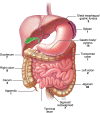Bowel perforation in intestinal lymphoma: incidence and clinical features
- PMID: 23704194
- PMCID: PMC3755328
- DOI: 10.1093/annonc/mdt188
Bowel perforation in intestinal lymphoma: incidence and clinical features
Abstract
Background: Perforation is a serious life-threatening complication of lymphomas involving the gastrointestinal (GI) tract. Although some perforations occur as the initial presentation of GI lymphoma, others occur after initiation of chemotherapy. To define the location and timing of perforation, a single-center study was carried out of all patients with GI lymphoma.
Patients and methods: Between 1975 and 2012, 1062 patients were identified with biopsy-proven GI involvement with lymphoma. A retrospective chart review was undertaken to identify patients with gut perforation and to determine their clinicopathologic features.
Results: Nine percent (92 of 1062) of patients developed a perforation, of which 55% (51 of 92) occurred after chemotherapy. The median day of perforation after initiation of chemotherapy was 46 days (mean, 83 days; range, 2-298) and 44% of perforations occurred within the first 4 weeks of treatment. Diffuse large B-cell lymphoma (DLBCL) was the most common lymphoma associated with perforation (59%, 55 of 92). Compared with indolent B-cell lymphomas, the risk of perforation was higher with aggressive B-cell lymphomas (hazard ratio, HR = 6.31, P < 0.0001) or T-cell/other types (HR = 12.40, P < 0.0001). The small intestine was the most common site of perforation (59%).
Conclusion: Perforation remains a significant complication of GI lymphomas and is more frequently associated with aggressive than indolent lymphomas. Supported in part by University of Iowa/Mayo Clinic SPORE CA97274 and the Predolin Foundation.
Keywords: lymphoma; perforation.
Figures
References
-
- d'Amore F, Brincker H, Gronbaek K, et al. Non-Hodgkin's lymphoma of the gastrointestinal tract: a population-based analysis of incidence, geographic distribution, clinicopathologic presentation features, and prognosis. Danish Lymphoma Study Group. J Clin Oncol. 1994;12:1673–1684. - PubMed
-
- Amer MH, el-Akkad S. Gastrointestinal lymphoma in adults: clinical features and management of 300 cases. Gastroenterology. 1994;106:846–858. - PubMed
-
- Otter R, Bieger R, Kluin PM, et al. Primary gastrointestinal non-Hodgkin's lymphoma in a population-based registry. Br J Cancer. 1989;60:745–750. doi:10.1038/bjc.1989.351. - DOI - PMC - PubMed
-
- Gou HF, Zang J, Jiang M, et al. Clinical prognostic analysis of 116 patients with primary intestinal non-Hodgkin lymphoma. Med Oncol. 2012;29:227–234. doi:10.1007/s12032-010-9783-x. - DOI - PubMed
-
- Kako S, Oshima K, Sato M, et al. Clinical outcome in patients with small-intestinal non-Hodgkin lymphoma. Leuk Lymphoma. 2009;50:1618–1624. doi:10.1080/10428190903147629. - DOI - PubMed
Publication types
MeSH terms
Grants and funding
LinkOut - more resources
Full Text Sources
Other Literature Sources


